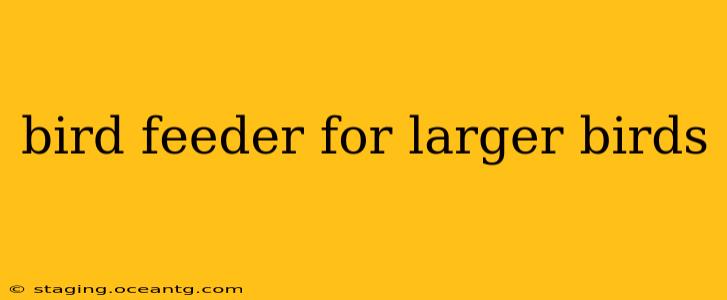Attracting larger birds to your backyard can be a rewarding experience. Their size and striking plumage make them a captivating addition to any garden. But feeding larger birds requires a different approach than catering to smaller species. This guide explores the best types of bird feeders and feeding strategies for successfully attracting these magnificent creatures.
What Makes a Bird Feeder Suitable for Larger Birds?
Larger birds, such as cardinals, blue jays, and even woodpeckers, have different needs than smaller birds like finches or hummingbirds. Their size and feeding habits dictate the type of feeder best suited to them. Key considerations include:
- Robust Construction: Larger birds are more powerful, so the feeder needs to withstand their weight and pecking. Look for feeders made from durable materials like metal or heavy-duty plastic.
- Larger Perches: The perches should be sturdy and wide enough to comfortably accommodate their size and weight.
- Larger Feeding Ports: The openings where the food is dispensed must be large enough for them to access the seed easily without struggling.
- Protection from Smaller Birds: Larger birds might be outcompeted by smaller, quicker birds. Consider features that deter smaller species, like larger openings or a platform design.
What Types of Bird Feeders Are Best for Larger Birds?
Several feeder designs cater specifically to the needs of larger avian visitors. Here are some popular options:
Platform Feeders:
These are the most straightforward and often the best option for larger birds. A simple platform provides ample space for birds to feed comfortably. Choose a platform feeder with high sides to prevent seed scattering and to help keep out squirrels.
Hopper Feeders:
Hopper feeders, with their covered tops and multiple feeding ports, are another good choice. Look for larger models with wider ports and sturdy construction. The covered design offers some protection from the elements.
Suet Feeders:
Larger birds, particularly woodpeckers and jays, appreciate suet, a high-energy food source. Suet feeders, often featuring cages or mesh baskets, are ideal for providing this rich food.
Tube Feeders (with modifications):
While standard tube feeders are generally designed for smaller birds, some modified versions with larger perches and feeding ports can also attract larger species. However, platform or hopper feeders are usually more successful.
What Kind of Food Should I Use?
The best food for larger birds depends on the species you hope to attract. Common favorites include:
- Black oil sunflower seeds: These are a popular choice for many bird species, including larger ones.
- Corn: Cracked corn is a good option, particularly for ground-feeding birds.
- Suet: High in fat and calories, suet is an excellent energy source for larger birds, especially during colder months.
- Peanuts: Unsalted peanuts in the shell provide a substantial and enjoyable treat. Note that some municipalities have restrictions on the disposal of peanut shells.
Avoid: Small seeds like millet are usually picked over by smaller birds before the larger birds can reach them.
How to Attract Larger Birds to Your Feeder:
Successful bird feeding is about more than just the feeder itself. Consider these tips:
- Location: Place your feeder in a visible, protected location away from dense vegetation, allowing for easy access and avoiding ambush predators.
- Cleaning: Regularly clean your feeder to prevent the spread of disease.
- Fresh Food: Keep your feeder filled with fresh food, ensuring a consistent supply for your avian guests.
What About Squirrels?
Squirrels are notorious for raiding bird feeders. To deter them:
- Squirrel-resistant feeders: Some feeders are specifically designed with features to keep squirrels away, like cages or baffles.
- Strategic placement: Placing the feeder in a location where squirrels have difficulty accessing it can also help.
Frequently Asked Questions (FAQ):
What is the best bird feeder to deter squirrels?
While no feeder is completely squirrel-proof, squirrel-resistant feeders with baffles or cages are significantly more effective than standard feeders. Careful placement also helps.
How often should I clean my bird feeder?
Clean your feeder at least once a month, or more often if you notice mold or other signs of contamination.
What are some other ways to attract larger birds to my yard?
Providing a water source, planting native plants that produce berries and seeds, and creating a habitat that offers shelter will further enhance your chances of attracting larger birds.
By carefully choosing the right feeder, providing appealing food, and considering the placement and maintenance, you can create a thriving bird sanctuary that welcomes a variety of larger bird species. Remember, patience is key – it might take some time for birds to discover your new feeder. But the reward of observing these magnificent creatures up close is worth the effort!
